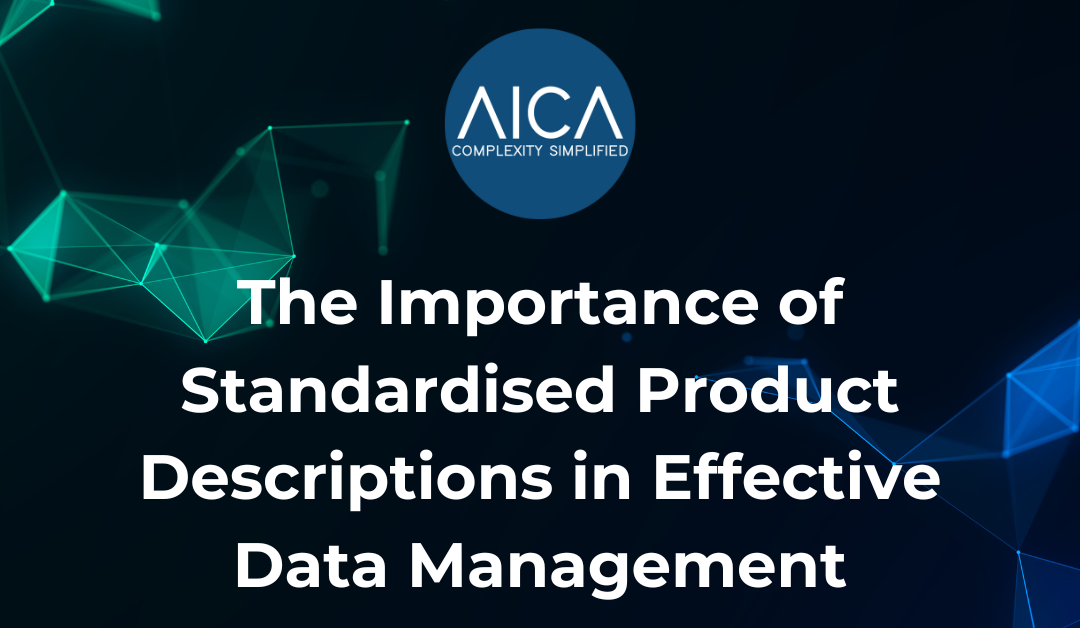Product descriptions play a vital role in supply chain management, procurement, and inventory control. They provide critical details about items, enabling accurate identification, comparison, and decision-making. However, the lack of standardised product descriptions is a common challenge for many organisations, particularly those managing extensive catalogues sourced from multiple manufacturers.
With each manufacturer presenting product descriptions in varying formats, inconsistencies arise, creating complications in data management, procurement efficiency, and operational clarity. This article explores the importance of standardised product descriptions, the challenges of achieving standardisation, and how AICA can help simplify this complex process.
Why Are Standardised Product Descriptions Important?
1. Improved Data Clarity and Consistency
Standardised descriptions ensure that product data is clear, consistent, and easy to understand. This eliminates confusion caused by inconsistent naming conventions, unit measurements, or incomplete details, making data more actionable.
2. Efficient Procurement Processes
When product descriptions are standardised, procurement teams can easily identify and compare similar products across suppliers. This facilitates better decision-making, quicker order placements, and improved cost savings by avoiding redundant or incorrect purchases.
3. Enhanced Inventory Management
Accurate and uniform product descriptions make it easier to track and categorise inventory. With consistent data, organisations can reduce overstocking, avoid stockouts, and streamline warehouse operations.
4. Better Spend Analysis
Standardised descriptions support accurate spend analysis by enabling the grouping of similar products and services. This categorisation helps in identifying cost-saving opportunities, supplier consolidation, and bulk purchasing discounts.
5. Support for Compliance and Reporting
Many industries require detailed and consistent reporting for regulatory compliance. Standardised product descriptions simplify this process by ensuring that data meets required standards and formats.
The Challenge of Non-Standardised Product Descriptions
- Diverse Manufacturer Formats
Manufacturers often provide product descriptions in their proprietary formats, focusing on what they believe is most relevant. These descriptions vary widely in detail, structure, and terminology, making it difficult for organisations to create a cohesive dataset.
For example:- Manufacturer A describes a product as “Hydraulic Pump – 12V.”
- Manufacturer B uses “12V Electric Hydraulic Pump.”
- Manufacturer C lists “Pump, Hydraulic, 12 Volts.”
- While these refer to the same item, the variations create inconsistencies that complicate data management.
- Incomplete or Inaccurate Information
Some manufacturers may omit critical details such as specifications, dimensions, or material compositions, leading to incomplete product descriptions. Without these details, organisations risk making errors in procurement or inventory management. - High Volume of Data
Organisations often manage thousands or even millions of product entries, making manual standardisation an overwhelming task. The sheer volume of data exacerbates the complexity of ensuring consistency across all descriptions. - Inconsistent Units of Measurement and Terminology
Differences in units of measurement (e.g., metric vs. imperial) or terminology (e.g., “tonnes” vs. “tons”) can lead to further inconsistencies, impacting accuracy in operations and reporting.
Steps to Achieving Standardised Product Descriptions
- Define a Standard Format
Establish a clear and consistent template for product descriptions, including mandatory fields such as product name, specifications, dimensions, material, and usage. - Classify Products Effectively
Use classification systems like UNSPSC codes or other industry standards to group similar products and ensure consistency in categorization. - Incorporate Validation Rules
Set up validation rules to enforce standardisation during data entry, such as requiring specific fields and using predefined naming conventions. - Enrich Data with Missing Attributes
Fill in missing details by enriching product descriptions with specifications, compatibility information, and classifications. - Conduct Regular Audits
Perform routine data quality checks to identify and resolve inconsistencies in product descriptions.
How AICA Simplifies Product Description Standardisation
AICA understands the challenges organisations face in achieving standardised product descriptions. Our AI-powered platform combines advanced algorithms with expert oversight to streamline and enhance the process of standardising product descriptions.
Here’s how we help:
- AI-Driven Standardisation
Our platform uses sophisticated algorithms to analyse and reformat product descriptions into a standardised structure. By identifying patterns and discrepancies across large datasets, AICA automates a significant portion of the standardisation process. - Manual QA/QC for Accuracy
While our AI handles the bulk of the work, we integrate manual quality assurance and control (QA/QC) to ensure that all descriptions meet high standards of accuracy and relevance. Our subject matter experts review and refine the data for exceptional quality. - Data Enrichment
We enrich product descriptions with missing attributes, classifications, and industry-standard codes (e.g., UNSPSC), creating a complete and actionable dataset. - Seamless Integration
AICA’s platform integrates directly with ERP, MDM, PIM, and inventory systems, ensuring that standardised descriptions flow seamlessly across all organisational systems and processes. - Customizable Solutions
Every organisation has unique needs. We offer customizable services to align with your specific requirements, ensuring that your product data management goals are met effectively.
Final Thoughts
Standardised product descriptions are essential for efficient data management, streamlined procurement, and effective decision-making. However, the path to achieving standardisation can be challenging, especially when dealing with diverse manufacturer formats and large datasets.
Ready to transform your product data management? Contact AICA today to learn how our platform can help you achieve standardised, enriched, and reliable product descriptions that drive operational success.
Copyright Reserved © AICA Data International Ltd 2024

